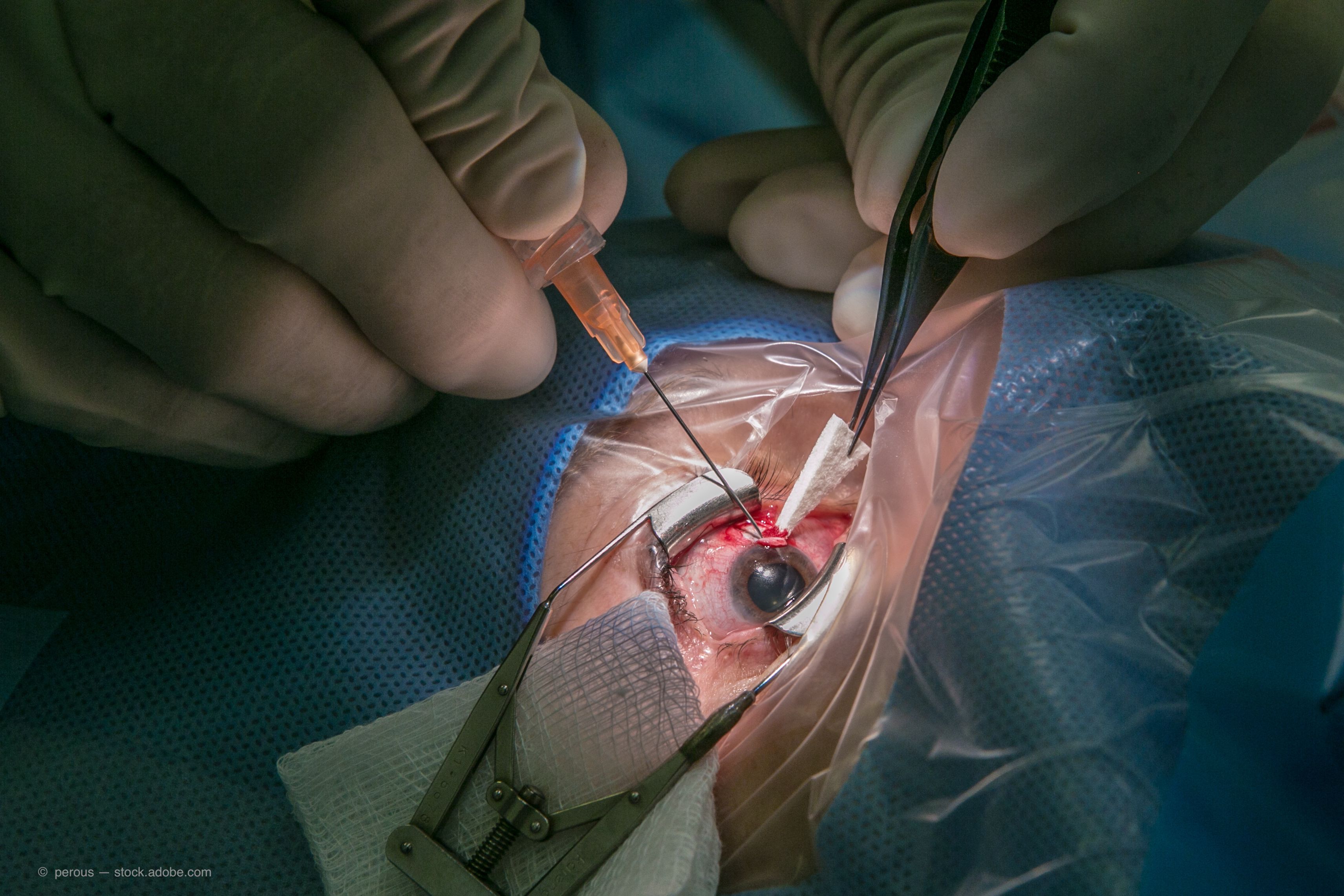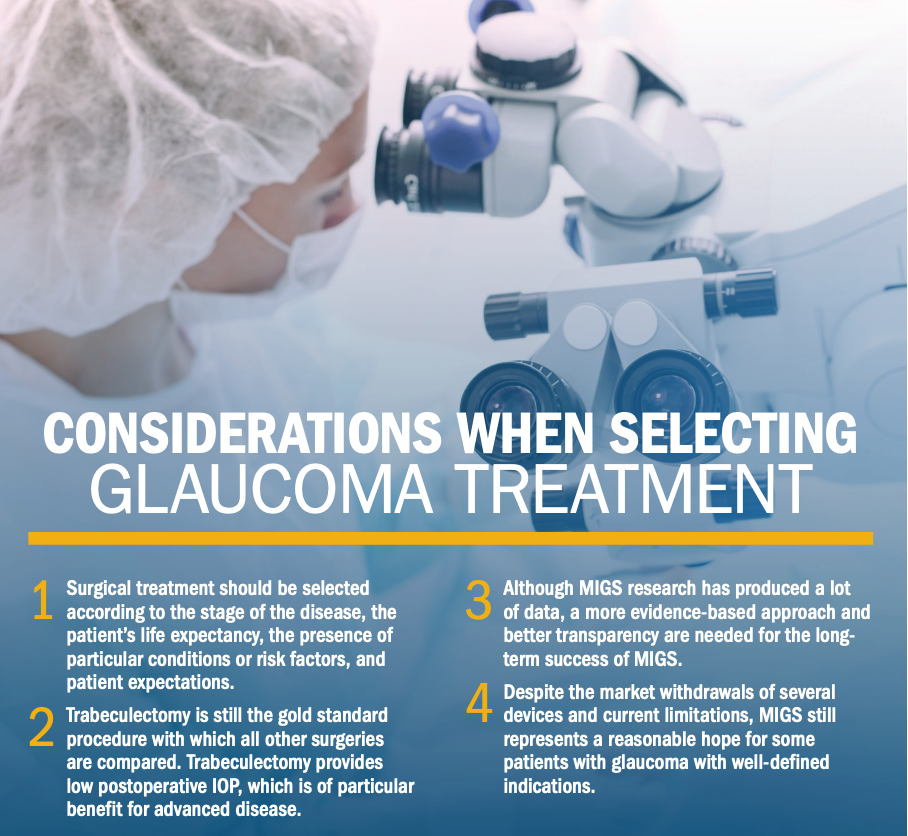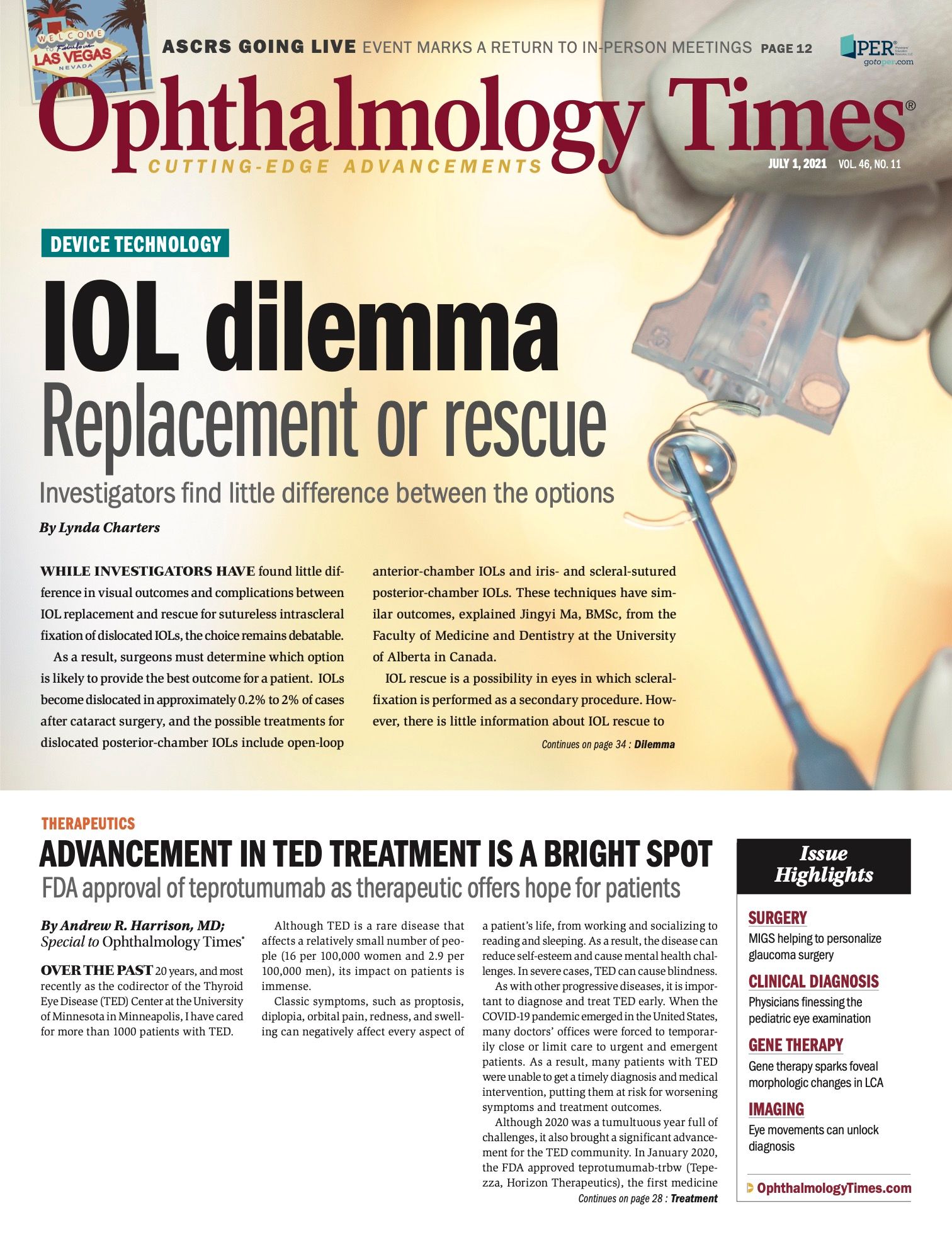Publication
Article
Digital Edition
MIGS helping to personalize glaucoma surgery options
Although minimally invasive procedure gives hope, additional research is required.

Special to Ophthalmology Times®
When trabeculectomy was first described in 1968, it was the only surgical procedure available for patients with progressive glaucoma or those unable to use topical medication.1
In recent years, precision—or personalized—medicine has emerged as a new and appealing concept to meet the need for individualized treatment that integrates a patient’s clinical, lifestyle, and genetic data, along with other biomarkers.
With respect to glaucoma surgery, the concept of personalized treatment is relevant because surgeons have to adapt not only to different patients—their age and life expectancy, potential systemic diseases, psychological state and social environment—but also to each individual eye with its specific stage of disease, the initial untreated IOP, optic nerve susceptibility, and other potentially relevant risk factors.2
There is a wide range of procedures that can be adapted to a patient’s individual profile and to the surgeon’s experience.
Related: Modifying and optimizing a new era of glaucoma surgeries
Recent research has focused on combining deep clinical phenotyping with genomics, proteomics, and metabolomics in order to find new biomarkers that could help stratify patients at risk of scarring.3
This approach is promising and will certainly bring new opportunities to the personalization and choice of surgical therapy.4
Successes and risks with trabeculectomy
Over the years, trabeculectomy has evolved in terms of safety and efficacy, particularly with the use of antimetabolites, representing today the gold standard with which all other surgeries are compared.
Well-performed trabeculectomy with antifibrotics has an overall success rate of 87% at 2 years5 and performs better than tubes as primary surgery.6
When reaching postoperative IOPs in the low teens, levels targeted in particular for advanced disease, the technique has been reported to reduce the rate of progression on longer follow-up.7,8
However, there are cases with a higher risk of failure or complications following trabeculectomy, particularly with the use of mitomycin-C or 5-fluorouracil.
Related: Study: Lower IOP, medication burden in OAG patients
Patients with multiple operations, secondary glaucoma, complex anterior segment dysgenesis, or aphakia would be better candidates for tubes,6 whereas patients with advanced glaucoma or highly myopic eyes or young male patients with myopia should be offered a less-invasive approach in order to reduce complication rates.
While controversial, nonpenetrating surgery can be a reasonable alternative to trabeculectomy for primary and secondary open-angle glaucoma.
It significantly reduces postoperative complications while providing good long-term IOP control.9,10
Deep sclerectomy and canaloplasty with 360° probing of the Schlemm’s canal can be performed as standalone procedures or in combination; however, in general these interventions are performed by only a handful of surgeons because of their surgical complexity or difficulty and the long learning curve in mastering the techniques.
In addition, these procedures are rather time-consuming in the learning phase, which is usually not compatible with a busy outpatient surgical theater.

In addition, MIGS is supposed to lower the burden of medication, which appears to be an important factor for most patients with mild to moderate glaucoma, for whom most MIGS devices are approved.11
Although the hope generated by these innovations for both patients and surgeons is indisputable, there needs to be a clear definition of the real value, position, and indication of these new techniques based on scientific, medical, and economic arguments.
There are several unmet needs with MIGS and other devices that are often wrongly referred to MIGS, discussed as follows.

Lack of clear definition
Different devices and techniques are coined MIGS although each has physical and surgical particularities that affect the associated learning curve, the invasiveness of the procedure, and its safety and efficacy.
According to European Glaucoma Society Guidelines, the terms microinvasive or minimally invasive are based on the notion of the extent of conjunctival dissection: only techniques and devices with minimal scleral and conjunctival manipulation should be called MIGS.
Devices that need conjunctival preparation, additional use of high concentrations of mitomycin C, or invasive postoperative manipulation performed in operating rooms should not be called MIGS.
Related: The use of MIGS trends and patterns in the US
This is in line with the 5th edition of the European Glaucoma Society Guidelines: MIGS devices are defined as those that enter the anterior chamber and target the trabecular meshwork, Schlemm’s canal, or suprachoroidal space without manipulating the conjunctiva and sclera.
Thus, the devices (Xen gel stent, Allergan) and (PreserFlo microshunt, Santen Inc.) are excluded.12
Publication quality
More robust studies to compare MIGS techniques and devices with conventional surgeries and with one other are needed.
MIGS devices have been used in combination with cataract surgery in some studies, thereby confounding the IOP-lowering effect of the device and the effect of phacoemulsification.
We find that others carry biases that range from conflict of interest, selection, and performance bias to detection, attrition, and reporting biases.13
Contradictory results reported in some publications may affect the credibility of the authors and companies.
In 1 article in which the authors report 22 cases (11.9%) of reformation of the anterior chamber, they state that only 3 cases had hypotonia and no cases had a narrow anterior chamber.14
Related: Standalone MIGS delivers durable IOP control in phakic eyes
A recent publication in a journal with a high impact factor reported the pleasant sensation of the ocular surface stated by the 5 patients included in the trial but omitted to mention postoperative IOP as 1 of the most important end points.15
Poorly established cost-effectiveness balance
The author of a recent publication stated that some devices increase the cost of cataract surgery without any benefit and that phacoemulsification alone is better than most MIGS in early-stage glaucoma, giving a drop in IOP that can last for several years.16
Among several other studies on the subject is a report, that includes results from 5 years of follow-up show that minimally invasive glaucoma surgery (MIGS) with simultaneous implantation of 2 trabecular microbypass stents (iStent Inject, Glaukos) combined with phacoemulsification is safe and provides durable moderate lowering of IOP.
Another study found that the implantation of 2 trabecular micro-bypass stents is a safe and effective standalone treatment for open-angle glaucoma that provides long-term reduction of IOP previously uncontrolled by a single topical medication.
There are financial considerations, with the cost of MIGS devices in most European countries is approximately 1000 Euros, far higher than the usual cost of surgical glaucoma management.
MIGS and other new devices would be cost-effective in cases where they would allow for complete and prolonged cessation of topical drugs.
Related: Eliminating the potential land mines in glaucoma surgery
Two recent Cochrane reviews stated that the iStent (Glaukos) and Hydrus MIGS devices reduce the need for drugs to some extent but do not erase the need for medication completely.17,18
In addition, the number of postoperative visits and manipulations as well as reoperations is not reduced, in particular for those devices relaying on subconjunctival blebs (Xen gel stent, Allergan; Preserflo microshunt, Santen).14
Conflicts of interest
It is common and highly desirable for key opinion leaders (KOLs) and societies to advise companies on new developments and to promote their utilization.
There can be instances when transparency is important.
For example, during a meeting or in a publication, a KOL may praises devices/MIGS from one manufacturer over a competitor, which may raise the question of interests other than scientific.
Transparency at all levels is of the utmost importance for the sake of scientific rigor and patient safety.
Related: Study examines pairing phacoemulsification, implantation of microbypass stents
Uncertain indications
The apparent ease of the technique praised by the manufacturer, in particular when combined with phacoemulsification, may lead to misinterpretation by ophthalmologists and bring confusion between treating a disease (glaucoma) and treating its risk factor, ocular hypertension.
Most MIGS and subconjunctival devices lower IOP to the mid-teens and are therefore indicated for early or moderate glaucoma.
However, it can be speculated that in many of these cases, instead of the combined phaco-MIGS surgery, a simple lens extraction would have been sufficient to lower the IOP. More research may be needed to validate this belief.
Indeed, a recent article based on Medicare data reported that 41.2% of the operated patients had not received IOP-lowering treatment before the combined phaco-MIGS surgery and 29.5% had received only monotherapy.19
The paradigm has changed given the lower risk associated with MIGS compared with more invasive procedures.
Moreover, the fees for surgery in different countries and continents vary significantly when MIGS is added to cataract surgery.
Related: MIGS and cataract surgery option offers positive results
On the other hand, it will be of interest to establish whether MIGS in the long run will be able to lower the rate of progression of the disease while reducing IOP.
It also is important to validate the technique in a controlled manner before accepting the results. Further studies are needed to validate this approach.
Conclusions
We are certainly advancing in the process of a personalized approach to glaucoma surgery; 1 size does not fit all.
The many options available allow us to better stratify surgical treatment according to the stage of the disease, the age of the patient, and the presence of other systemic and/or local conditions as well as the expectations of each patient.
Although the hopes of the patients and the targets of the clinicians are the same, the expression of the requirements may differ.
For a patient, the main priorities may include keeping their independence and their ability to drive as well as using the least possible topical medication, whereas the surgeon’s priorities are target IOP, reduced disease progression, and the safety of the procedure.
The aims are complementary, and it should be possible to achieve both in a particular patient via a customized intervention.
However, the choice of surgical treatment should be evidence-based, in particular with new techniques, and this can only be achieved by performing robust randomized controlled trials as well as analyzing patient-related outcomes to confirm the validity and indication of each of the new techniques compared with conventional glaucoma surgery.
Despite the disappointments, market withdrawals of several devices, and current limitations, MIGS still represents a reasonable hope for some patients with glaucoma with well-defined indications.
Related: Drainage device offers IOP lowering capabilities at 1 year
Indeed, MIGS has brought new options to the management of glaucoma and has revived interest in the disease not only for glaucoma specialists but also for general ophthalmologists.
However, we should not sacrifice good practice and evidence for misplaced interest or misjudgment.
In the interest of our patients, we must retain evidence and transparency. Although all innovation is paved with difficulty, the effort is worthwhile.
Further steps to improve precision in surgical management of glaucoma may come with new diagnostic assessment tools of the outflow pathways, with better knowledge of genetic influence of the healing process, and use of big data and artificial intelligence.
However, although fascinating and expanding, these novelties are not yet designed for daily clinical practice.
--
About the authors
Gordana Sunaric-Mégevand, MD
e:g.su.meg@gmail.com
Sunaric-Mégevand is medical director of the Florissant Eye Centre and director of the Eye Research Centre at Adolphe de Rothschild Hospital in Geneva, Switzerland. She has no financial disclosures to make.
Alain M. Bron, MD
e:alain.bron@chu-dijon.fr
Bron is a professor of ophthalmology and head of the glaucoma unit at the University Hospital in Dijon, France. He acts as a consultant for Aerie, Allergan, Bausch + Lomb, Santen, and Théa.
---
References
1. Cairns JE. Trabeculectomy. Preliminary report of a new method. Am J Ophthalmol. 1968;66(4):673-679.
2. Bell K, Gramlich OW, Von Thun Und Hohenstein-Blaul N, et al. Does autoimmunity play a part in the pathogenesis of glaucoma? Prog Retin Eye Res. 2013;36:199-216. doi:10.1016/j.preteyeres.2013.02.003
3. Yu-Wai-Man C, Khaw PT. Personalized medicine in ocular fibrosis: myth or future biomarkers. Adv Wound Care (New Rochelle). 2016;5:390-402.
4. Sunaric-Mégevand G, Bron AM. Personalizing surgical treatments for glaucoma patients. Prog Retin Eye Res. 2021;81:100879.
5. Kirwan JF, Lockwood AJ, Shah P, et al. Trabeculectomy in the 21st century: a multicenter analysis. Ophthalmology. 2013;120(12):2532-2539.
6. Gedde SJ, Feuer WJ, Lim KS, et al. Treatment outcomes in the primary tube versus trabeculectomy study after 3 years of follow-up. Ophthalmology. 2020;127(3):333-345.
7. Iverson SM, Schultz SK, Shi W, Feuer WJ, Greenfield DS. Effectiveness of single-digit IOP targets on decreasing global and localized visual field progression after filtration surgery in eyes with progressive normal-tension glaucoma. J Glaucoma. 2016;25(5):408-414.
8. Mataki N, Murata H, Sawada A, Yamamoto T, Shigeeda T, Araie M. Visual field progressive rate in normal tension glaucoma before and after trabeculectomy: a subfield-based analysis. Asia Pac J Ophthalmol (Phila). 2014;3(5):263-266.
9. Bissig A, Rivier D, Zaninetti M, Sharaawy T, Mermoud A, Roy S. Ten years follow-up after deep sclerectomy with collagen implant. J Glaucoma. 2008;17(8):680-686.
10. Grieshaber MC, Peckar C, Pienaar A, Koerber N, Stegmann R. Long-term results of up to 12 years of over 700 cases of viscocanalostomy for open-angle glaucoma. Acta Ophthalmol. 2015;93(4):362-367.
11. Le JT, Mohanty K, Bicket AK, Tarver ME, Eydelman M, Li T. Identifying outcomes that are important to patients with ocular hypertension or primary open-angle glaucoma: a qualitative interview study. Ophthalmol Glaucoma. 2019;2(6):374-382.
12. European Glaucoma Society. Terminology and Guidelines for Glaucoma, 4th ed. Publicomm; 2020.
13. Agrawal P, Bradshaw SE. Systematic literature review of clinical and economic outcomes of micro-invasive glaucoma surgery (MIGS) in primary open-angle glaucoma. Ophthalmol Ther. 2018;7(1):49-73.
14. Schlenker MB, Gulamhusein H, Conrad-Hengerer I, et al. Efficacy, safety, and risk factors for failure of standalone ab interno gelatin microstent implantation versus standalone trabeculectomy. Ophthalmology. 2017;124(11):1579-1588.
15. Schultz T, Schojai M, Kersten-Gomez I, Matthias E, Boecker J, Dick HB. Ab externo device for the treatment of glaucoma: direct flow from the anterior chamber to the ocular surface. J Cataract Refract Surg. 2020;46(7):941-943.
16. Quigley HA. 21st century glaucoma care. Eye (Lond). 2019;33(2):254-260.
17. Le JT, Bicket AK, Wang L, Li T. Ab interno trabecular bypass surgery with iStent for open-angle glaucoma. Cochrane Database Syst Rev. 2019;3(3):CD012743.
18. Otarola F, Virgili G, Shah A, Hu K, Bunce C, Gazzard G. Ab interno trabecular bypass surgery with Schlemm’s canal microstent (Hydrus) for open angle glaucoma. Cochrane Database Syst Rev. 2020;3(3):CD012740.
19. Wang SY, Singh K, Stein JD, Chang RT. Ocular antihypertensive medication use after iStent implantation concurrent with cataract surgery vs cataract surgery alone in a large US health care claims database. JAMA Ophthalmol. 2019;137(1):21-27.

Newsletter
Don’t miss out—get Ophthalmology Times updates on the latest clinical advancements and expert interviews, straight to your inbox.




